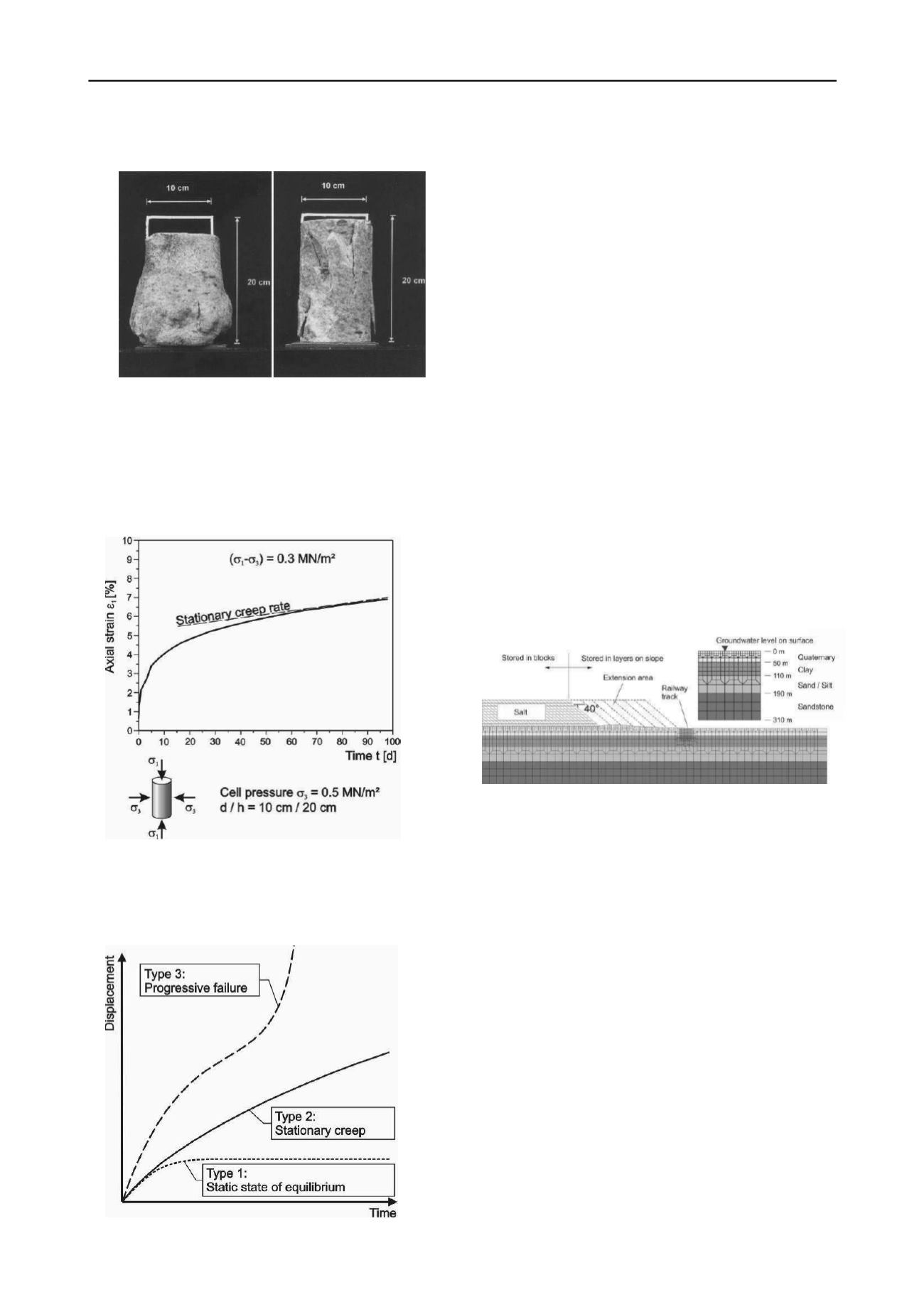
2029
Technical Committee 207 /
Comité technique 207
Figure 7. Specimens of triaxial tests with undercritical (left) and
overcritical (right) deformation rates.
Due to deviatoric stress levels the stockpiled material creeps
with high deformation rates at the beginning. The deformation
rate decreases under constant deviatoric stress dependent on the
time and approaches asymptotic the stationary creep rate
(Figure 8).
Figure 8. Typical creep curve of granular stockpiled material.
For further information of the material behaviour of granular
rock salt see
Fordham 1988
,
Munsan and Wawersik 1991
,
Chumbe et al. 1996
and
Boley 1999
.
Figure 9. Deformation rate dependent system behaviour.
Although the heaps have a slow creep deformation and the soil
has a continuously, slow changing load the heaps do not
collapse due to the viscoplastic material behaviour of the
granular rock salt as long as the deformation rate is
undercritical. The collapse of the slope of a heap only results
from a progressive failure (Figure 9) due to an increasing
overcritical deformation rate. The system behaviour of a heap
consisting of granular rock salt normally is like type 2 in
Figure 9, if there is no weakening in the contact area.
On the basis of more than 150 triaxial tests a constitutive law
for the material behaviour of granular stockpiled material was
developed at the Institute and Laboratory of Geotechnics of TU
Darmstadt (Boley 1999, Wachter 2009, Wachter and
Katzenbach 2009). This constitutive law was implemented in a
Finite-Element-Software for analyses of the ultimate limit state
(ULS) and serviceability limit state (SLS) of granular rock salt
heaps and infrastructures and buildings in the influenced area
around the heaps.
4 ANALYSES OF THE EXTENSION OF THE HEAP
For analyses of the extension of a tailings heap and the
influence on the railway track numerical simulations using the
FEM were carried out. The model has a length of 1,800 m. The
heap is 120 m high. Regarding the analyses of an extreme
situation the groundwater level was set to the surface. The soil
is modelled with an elastoplastic constitutive law based on a
modified Drucker-Prager-Modell, the new red sandstone was
modelled with an elastic constitutive law. The FE-Model is
shown in Figure 10.
Figure 10. FE-Model of the soil and the heap before and after the
extension.
The interaction between the tailings heap and the soil is
modelled by a contact surface. The shear strength is defined by
the friction law of
Coulomb
. The shear stress is proportional to
the vertical stress. The time dependent material behaviour and
the changing geometry of the heap are considered by a step-by-
step analysis.
Figure 11 shows the analysed cross sections. The horizontal
distance s
i
of the toe of the slope to the railway track is varying
along the track.
The relative deformations and the deformation rates have been
calculated. The deformation rates increase when the extension
approaches the railway track and decrease to a low rate when
the extension area is totally filled up.
Due to the complexity of the project and the interaction between
soil, heap and the infrastructure an extensive monitoring
program according to the observational method was installed.
The main part of the monitoring program consists of geodetic
and geotechnical measurements (Figure 12).
For example the measured, absolute, horizontal displacements
orthogonal
to
the
toe
of
the
slope
of
2 measurement points are presented. The measurement point
MR 54 is at the toe of the slope before the extension started.
The measurement point MR 51 had a distance of 150 m to the
toe of the slope before the extension started.


